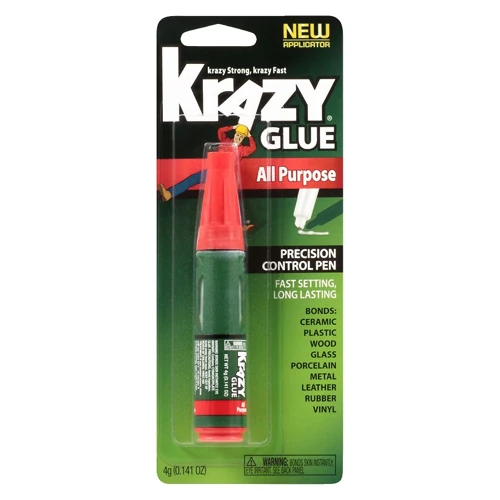When it comes to quick fixes and strong bonds, Krazy Glue is a household name that has earned its reputation for delivering impressive adhesion. The fascination with this super glue’s ability to mend broken objects is matched only by the curiosity surrounding its limits. In this exploration, we delve into the full potential of Krazy Glue’s strength, including the maximum weight it can support and its suitability for various applications.
Krazy Glue Strength Analysis
What Determines Krazy Glue’s Bonding Capacity
The bonding capacity of Krazy Glue is not a matter of chance; it’s a carefully engineered feature. Several factors come into play, including the cyanoacrylate formula which is the chemical backbone of Krazy Glue. The surface area and types of materials being adhered also significantly impact the bond. Proper application and environmental conditions can either enhance or detract from the glue’s effectiveness.
Krazy Glue Versus Epoxy: A Comparative Study
When considering adhesive options, Krazy Glue and epoxy often come to mind. Both are strong adhesives, but they cater to different needs. Krazy Glue, known for its rapid bonding time, is ideal for quick repairs. Epoxy, on the other hand, takes longer to cure but provides a bond that is resistant to heat and chemicals, making it suitable for more demanding applications.
The Maximum Weight Krazy Glue Can Hold
Factors Affecting Krazy Glue Weight Limit
The Krazy Glue weight limit is influenced by variables such as the type of materials being bonded, the surface texture, and the environmental conditions during application. The consistency of the adhesive layer and the total curing time also play critical roles in determining the ultimate hold.
Adhesive Strength and Load Capacity
Adhesive strength is a vital factor when it comes to load capacity. Krazy Glue provides a resilient bond that can withstand significant stress. The maximum weight Krazy Glue can hold is often a matter of context, varying based on the specifics of the application and the nature of the load, whether it’s static or dynamic.
Krazy Glue Durability Test
Testing Methodology
To objectively evaluate the Krazy Glue durability test, a standardized procedure is employed. This involves preparing test samples, applying the adhesive under controlled conditions, and subjecting the bond to weights until failure occurs. This method provides a clear picture of the glue’s performance under stress.
Results and Observations
The results from durability tests reveal Krazy Glue’s impressive holding power. While there is a range of outcomes depending on specific conditions, the adhesive consistently demonstrates an ability to support weights that are substantial relative to the small amounts of glue used in the bonding process.
Heavy-Duty Krazy Glue Uses
Practical Applications in Different Materials
Heavy-duty Krazy Glue uses span a variety of materials, including plastic, metal, ceramic, and wood. Its versatility makes it essential in both household repairs and in crafting, where creating a durable bond is crucial.
Case Studies: Krazy Glue in Action
Case studies of Krazy Glue demonstrate its effectiveness in real-world scenarios. From repairing broken tools to securing components in electronic gadgets, Krazy Glue proves to be a reliable solution for a myriad of bonding challenges.
Krazy Glue Holding Power: Real-World Examples
Everyday Household Fixes
Krazy Glue holding power can be seen in everyday household fixes. Whether it’s a broken vase, a loose shoe sole, or a detached cabinet knob, Krazy Glue provides a quick and strong bond that often surpasses expectations.
Industrial Use Cases
In industrial settings, the strength of Krazy Glue is put to the test with heavier loads and more demanding applications. Its performance in these scenarios speaks to the adhesive’s reliability and the confidence professionals have in its holding power.
Improving the Effectiveness of Krazy Glue
Surface Preparation Tips
- Clean the surfaces: Remove any oils, dust, or debris for the best bond.
- Roughen smooth surfaces: A slightly rough texture can enhance the glue’s grip.
- Ensure a tight fit: The closer the contact between the surfaces, the stronger the bond.
Application Techniques
Proper application is crucial for optimizing the performance of Krazy Glue. Apply a small amount of glue to one surface, press the pieces together firmly, and allow sufficient time for the glue to cure. Minimizing movement and maintaining stable environmental conditions during this time will also contribute to a stronger bond.
Conclusion: The Reliability of Krazy Glue
Summary of Findings
Our analysis has shown that Krazy Glue offers a formidable adhesive strength suitable for a vast array of applications. The maximum weight Krazy Glue can hold is subject to various factors, but when applied correctly, it can provide a surprisingly durable bond.
When it comes to household repairs or DIY projects, understanding the strength of your adhesive is crucial. If you’re curious about the capacities of different types of glues, you may want to explore our comprehensive guides. We’ve covered topics like how much weight wood glue can hold, which might surprise you with its resilience. For a more specific scenario, check out our focused discussion on how much weight a second type of wood glue can hold. And if you’re working with PVC, our article on how much pressure PVC glue can withstand can provide you with the necessary insights. If Krazy Glue is your adhesive of choice, understanding these comparisons can give you a ballpark idea of its strength in various applications.
Recommendations and Best Practices
For optimal results, consider the materials you are bonding, prepare the surfaces properly, and apply the glue with care. By following these guidelines, you can maximize the bonding capacity of Krazy Glue and ensure long-lasting hold for your repairs and projects.


